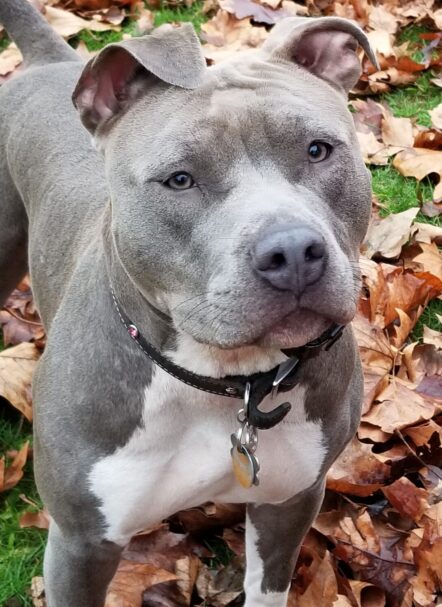menu
Blue Nose Dogs
Pit Bull Coat Colors

Fascination with Blue Nose Dogs
One of the more popular colors is "blue nose". Within Pit Bull circles, you will hear "blue nose dog" and "red nose dog" quite often. Many people looking for Pit Bulls "think" being a blue nose makes them unique. However, there is no real difference between a blue-nose Pit Bull and other Pit Bulls. Blue-nose Pit Bulls are not a separate breed or even a bloodline; it is just a defect in one dog's genes, which has been bred into the dog. The gene could quickly disappear in puppies if the dog is bred with a non-carrier of the recessive gene.
Pit Bulls come in an array of amazing colors, despite the huge variety in coat color, there are only two basic pigments that determine the color of canines: eumelanin (black) and phaeomelanin (red). All different variations in color are created by these two pigments, which are both forms of melanin.
Standard Colors
- black
- black brindle
- blue
- blue brindle
- blue fawn
- red
- red brindle
- fawn
- fawn brindle
- fawn sable brindle
- tan
- buckskin
- seal
- tricolor
- reverse brindle
Non-standard
- merle
- black and tan
- liver
- liver brindle
- white or albino
- and 80% white
"Blue" is a term frequently used in the dog world that describes a gray color ranging from light silver to deep charcoal. Blue-nose Pit Bulls have a gray or near-black nose and a "blue" gray coat.
Blue-nose Pit Bulls are normal dogs who simply display a particular color pattern. For example, they have "blue" actually "gray" coats, and their noses match their coat color. Aside from this coloration, they do not exhibit any significant differences from other Pit Bulls. Like all Pit Bulls, blue nose dogs are generally friendly, human-orientated dogs who make good pets for suitable families.
However, to understand blue-colored dog coats a little better, you have to look at genetics These genes affect the amount of melanin in every hair shaft from head to toe, making your dog dark, light, or a mix of color.
Dilution of Black
Despite the selection of different colors and coat patterns of dogs, there are just two basic pigments at the root of them all: red (pheomelanin) and black (eumelanin). In simpler terms, blue nose Pit Bulls are not blue. Instead, they exhibit an appearance best described as diluted black.
Selective Breeding
The problem with this type of color is that to retain this blue color; there does have to be pretty selective breeding. Many Pit Bulls are being bred with their family members. Inbreeding of dogs can have its consequences. Blue coloration is a recessive gene, and you would need two parents carrying the same gene to make a blue puppy. It also means that blue nose Pit Bulls can produce non-blue offspring.
Health Differences
There are some slight health differences associated with the blue coloring. The beautiful blue-gray coat of blue-nose Pit Bulls is rare and sought-after coloring by fans of the breed. Unfortunately, the recessive gene responsible for the striking coloration - along with poor breeding practices - also makes this coloration type one of the most prone to skin disorders among Pit Bulls. As a result, they tend to have more skin allergies and alopecia, thin, dull hair that appears in adolescence and can continue throughout their lifetime.
Personalities
Some dog fanciers think that personalities vary by the dogs color, but
this is not true. Breeding and rearing influences personalities and personalities differ from dog to dog. The color of the coat has no bearing on this. Consider the temperament and personality of the dog when selecting one. Remember, a dog is an individual, and anything you may have
heard about specific colors may not ring true with the dog you get.

